#victorian sewing patterns
Text

My first ever victorian outfit is DONE! I made all these things!!
#adventures in sewing#arts n crafts#the skirt and jacket are both made from 1895 patterns#the shawl is from an 1860s pattern#everything else is improvised lmao#i also have a stripey button up shirt and another petticoat#i'll get someone to take good pictures in daylight this weekend#so people can finally see my outfit is blue and not black lmao#anyway all of my clothes have massive flaws#but for a first ever victorian set (where i used actual patterns!) and after just one year of sewing#and i did a lot of this by hand and often while sick too#so i'm happy (or at least trying to convince myself i'm happy)
131 notes
·
View notes
Text
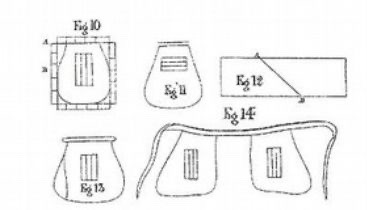
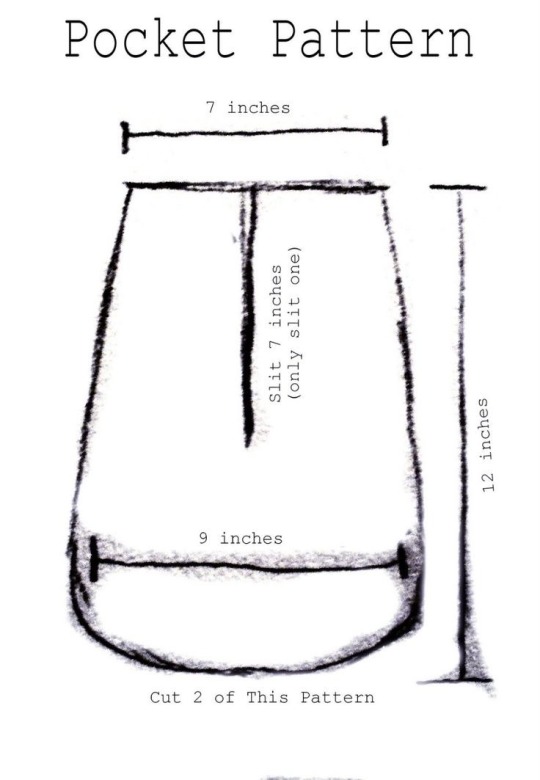
Sewing Pattern For Pockets
#historical fashion#fashion#historical#history#historical clothing#historical dress#long dress#victorian#victorian era#victorian fashion#pockets#18th century fashion#18th century#19th century fashion#19th century#textile#textiles#sewing#sewing patterns#historical pattern#victorian pattern#patterns#pattern#art
88 notes
·
View notes
Text
I don't know who needs to hear this but Victorian patterns are literally free on the internet. You can find most pre-1920s clothing patterns for free. Look into archives for any scanned pattern books
#sewing#pattern#patterns#clothing pattern#clothing patterns#patternmaking#archive#archives#archival#archived books#vintage fashion#vintage sewing#Victorian fashion#victorian sewing#tudor fashion#tudor sewing
44 notes
·
View notes
Text
You may remember me putting out a graded version of this same pattern months ago. However, I actually pulled it when someone bought it and told me that the grading was so messed up that it shouldn't be offered for sale, and then I never got around to fixing it because I don't know what I'm doing in the grading arena and I doubt I ever will, without the time and energy to do extensive mockups myself.
I've decided that it makes the most sense for me to simply make gridded patterns à la Janet Arnold and sell them for significantly less than graded ones, since they represent less time on my part and more difficulty on the users', if they want to turn them into actual clothing. They can also be used for research purposes much more readily than the graded patterns.
So you can certainly look out for more of these in the future!
63 notes
·
View notes
Text
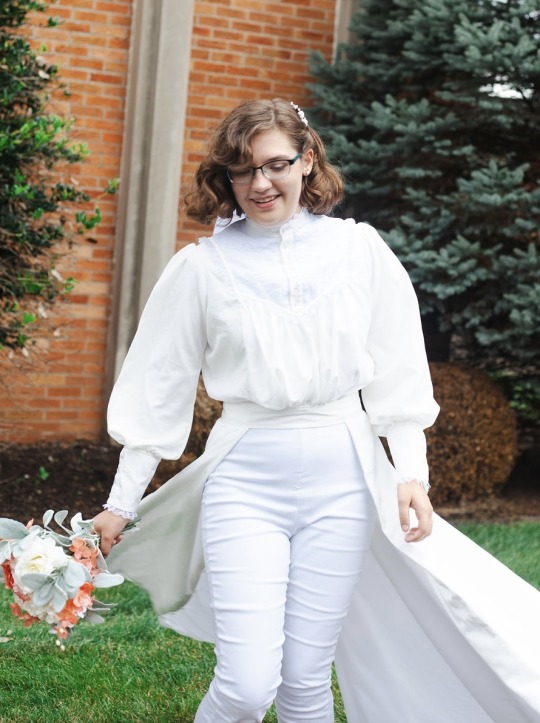


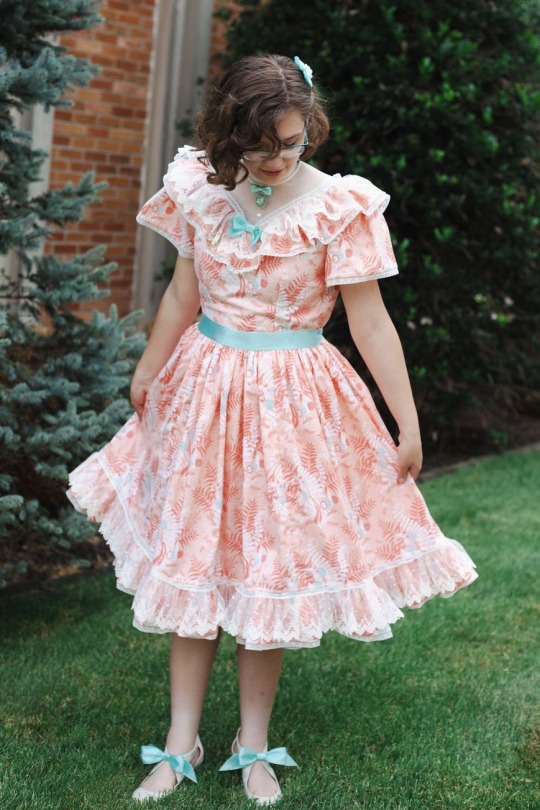
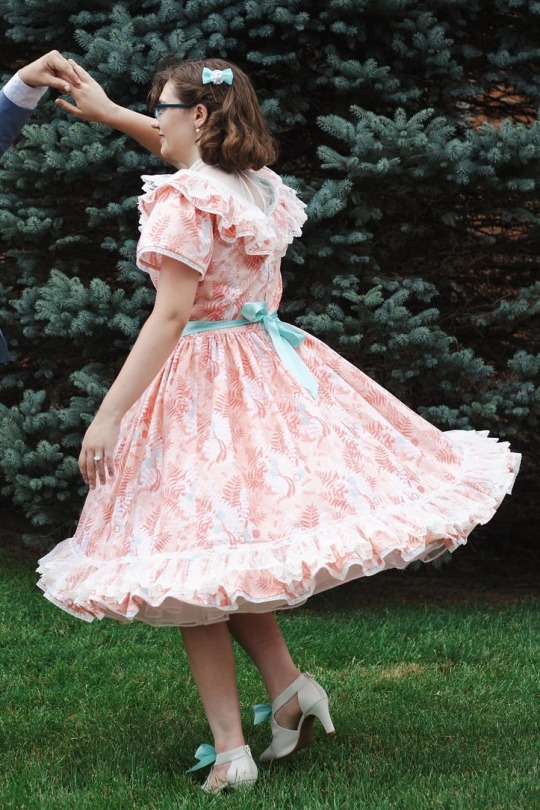
I got married this summer!! And I spent the year leading up to it designing & patterning & making my dresses! So here they are; unfortunately my photo selection is pretty limited cause our photographer got almost no fullbody pictures of me alone from the front, but w/e
My wedding dress/outfit/what have you consisted of an Edwardian-ish blouse and a skirt which I drafted off of an actual Victorian walking skirt pattern except since I didn’t wanna obtain/wear a corset & bustle I took out the hip shaping so it just turned out to be a partial circle skirt that’s a little longer and fuller in back. Oh, and the front panel was actually two overlapping panels which could be folded back and attached to the inside of the skirt. I wore it closed at the actual marriage part which I didn’t get good pics of, and open at the ring ceremony, which is where all the above pics were taken. The pants were resale, but I did make my veil and bouquet!
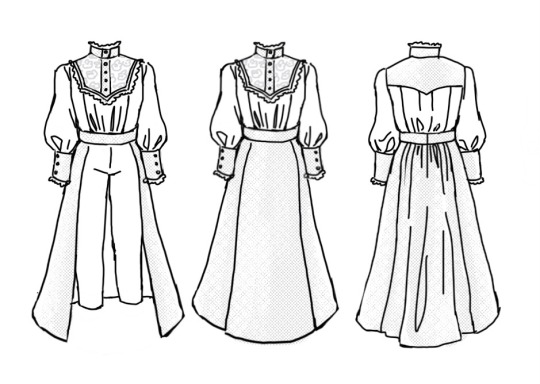
The second dress was very inspired by this set of classic lolita OP’s (particularly the one in the first two pics) which I first saw back in 2021 and I’d been itching to make something similar ever since, so I picked up the fabric for it when it was on sale back at my old job and then pencilled it in as my reception dress so I would actually get around to making it. (Although fun fact both of these outfits STILL need more sewing done before they’re completely ready for regular wear lol. Someday) I got the cameo for the brooch off Etsy (it has a butterfly on it) and my grandma bought me the shoes for Christmas last year, though I added the bows to them (they’re removable and I also made a pink set) and also made the earrings and hair bow.
Anyway we recently got done moving and stuff so hopefully I will be able to do more art soon! (Also they/them preferred as usual 💜)
#sewing#victorian#edwardian#lolita#wedding#ok search tags are done I can relax#Yes my wedding dress was very hot to wear outdoors but I didn’t wanna make it for just one event so it’s also my temple dress#which had certain requirements including long-ish sleeves#I call the reception dress my snail dress because the fabric is patterned with ferns and mushrooms and one little snail per repeat#continuing the animal trend of my peacock skirt & bee shirt & butterfly dirndl#also not very visible in the photos but covering up the ruffle seams are length of lace which I snipped slits in to run tiny ribbon through#and then I had to sew it on BY HAND and oh man that yoke seam got sooooooooooo thick with the ruffled net lace and tulle#(which were nylon cause that’s all I could get cheap in person at joannes & such) and also several layers of quilting cotton#I never would’ve finished both dresses (the exterior at least) if I hadn’t tried taking aripiprazole for a month#cause I got the whole skirt for the snes (snail dress) finished in like A WEEK#sadly it gave me weird physical side effects so I had to stop taking it. sadge#oh yeah also I finally drafted my own bodice block for the snes cause I couldn’t find any princess seamed high neck bodice patterns#and for the white blouse I made changes to the shoulder seams and collar of my bee shirt pattern buuuut I probably shouldn’t have#ended up a bit wonky#anyway future planned projects include… watercolor painting for the apartment (feat. kirby)#Elfilin/Elfilis gijinkas which are. being somewhat difficult#Magolor gijinka minecraft skin LOL (I have the account migration cape and it goes perfectly with his EX colorway)#not sure if I’ll ever get around to finishing that pmv. we’ll see
45 notes
·
View notes
Text
Part 13 of A Treatise of Embroidery, crochet, and knitting with illustrations
By George C. Perkins, Anna Grayson Ford, and M. Heminway & Sons Silk co circa 1899
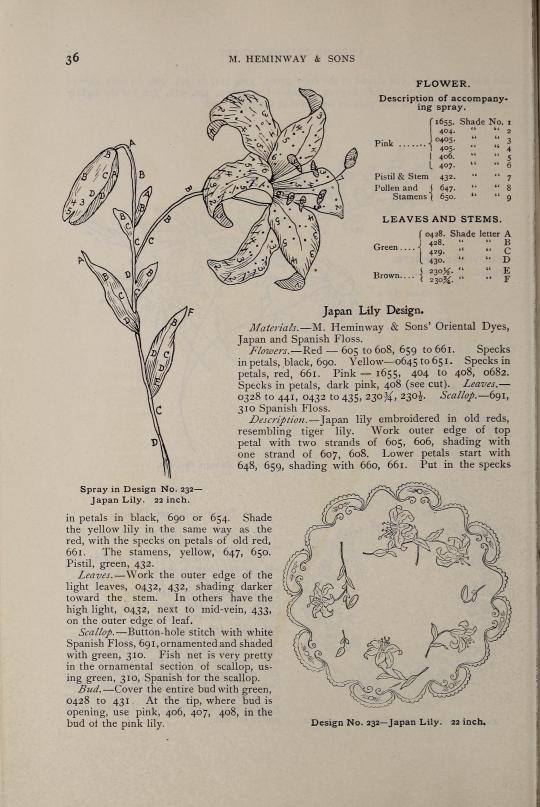

Please note, this book was written in 1899, and as such uses a racist term to refer to the dyes that were used for the thread. If you'd like to read more about this period in time, the term, and the stereotypes that the Victorians had, I've actually linked the wikipedia article here that goes more in depth. It's not the end all be all of it, but it's a good starting place for anyone wanting to educate themselves on the topic.
So the lily that is shown on this page, when I looked it up is called Lilium Speciosum. This lily is native to Southeast China, Japan, and Taiwan, and was introduced to English Gardeners in 1830. Trying to find the common names for it by the way has been a nightmare. In English it took me longer than it should have to find that it's called the Japanese Lily, Japanese show lily, or Rubrum Lily nowadays.
Japanese Wikipedia when translated gives me Kanokoyuri, Doyou Lily, and Tanabata Lily as common names and much more information on the background than I can find on any of the English language websites I came across, so I've included a DeepL translated version of the Japanese Wikipedia page below.
"Kanokoyuri (scientific name: Lilium speciosum) is a perennial herb in the lily family, Liliaceae. It is also known as the Doyou lily and the Tanabata lily.
Characteristics:
The distribution is Kyushu (mainly from the Satsuma Peninsula to the coast of Nagasaki Prefecture), Shikoku (in the mountains of Ehime and Tokushima Prefectures), northern Taiwan, and Jiangxi Province, China, with the highest density of native plants in Japan in the Koshijima Islands. The grass is 1 to 1.5 m tall, and the flowering season is from July to September. The flowers, which are about 10 cm in length, are beautiful and have been cultivated for ornamental purposes since ancient times. The Japanese name is derived from the petals, which are spotted with a fawn pattern.
In the Edo period (1603-1867), Philipp Franz von Siebold brought bulbs of the canary lily out of Japan, and it is said to be the first Japanese lily to become known in Europe. During the Meiji period, the bulbs were boiled and dried and exported to China as a confectionery ingredient. In the Taisho era (1912-1926), bulbs were exported to the United States and used as fresh flowers for Christmas and Easter. In the postwar period, demand for lilies as ornamental flowers increased overseas, and during the period of rapid economic growth, breeding efforts were made to produce high-quality lilies, but from the 1970s onward, overseas demand declined.
Translated with DeepL.com (free version)"
I also translated the Chinese Wikipedia page, which gave me a common name of Deer Lily due to the spots. The translated Chinese Wikipedia Page via DeepL gives me a ton more information so I've also included it here:
"also known as Lilium glaucum (Taiwanese: iām-hông lo̍k-á pik-ha̍p), Lilium beautifulum, Lilium medicum, Lilium glaucum, Lilium magenta, Lilium septuagenarianum, Lilium hyacinthum, and Lilium speciosum, is a species of lily in the family Liliaceae. It is a plant of the genus Lilium, with the species addition speciosum meaning "beautiful", and is found in Kyushu and Shikoku, Japan, Taiwan, and southern China, and is named for its flowers, which are covered with brilliant spots that resemble deer stripes. In Taiwan, there is a variety of red deer lily (Lilium speciousm var. gloriosoides) covered with reddish spots, which is endemic to Taiwan, and is also the curatorial flower of the National Museum of Natural Science in Taiwan, and is regarded as "the most beautiful lily in East Asia".
The bulbs are nourishing, strengthening, diuretic, cough suppressant, antipyretic and anti-inflammatory. In Japan, the flower language of the Kagoshima lily is "solemnity" and "compassion".
Growth:
It grows in the low altitude mountains of northern Taiwan, on rocky, exposed, sunny slopes."
"Uses:
The bulbs are edible, rich in starch, and taste like potatoes. Deerberry lilies are so popular that there has been a lot of research into breeding them, and as a result there are cultivars of deerberry lilies in many gardens. People have crossed Deer Lily with Lily of the Valley to produce some valuable varieties, such as the "Imperial" series, and in 1964, the Japanese selected and bred the "Uchida" deep pink flower disease-resistant varieties from the Deer Lily.
Problems"
The red deer lily is currently endangered, with a small growing area, few breeding sites, and a decreasing number of growing areas and populations."
I've included the translations as is, but as we know, translation programs are dubious at best and unfortunately I lack the language skills to make sure that it translated properly. So if anyone who speaks Japanese, Chinese, or any of the other languages of the different areas this plant is native, can verify if the translation is accurate, tell me other common names of these lilies, and/or give me more information if possible, it would be much appreciated!
Onward to the diagram description:
Flower.
Description of accompanying Spray.
Pink:
1655 = Shade number 1, 404 = 2, 0405 = 3, 405 = 4, 406 = 5, 407 = 6.
Pistil & Stem:
432 = 7.
Pollen and Stamens:
647 = 8, 650 = 9.
Leaves and Stems.
Green:
0428 = Shade letter A, 428 = B, 429 = C, 430 = D.
Brown
230 1/2 = E, 230 3/4 = F.
A graceful stem with alternating leaves going up it has a single speckled lily branching off to the right and further up a larger bud is bowed over facing the left.
The stem starts with D and changes to C as it reaches the first leaf on the right side.
Leaf 1: Starting from the bottom of the leaf and going row by row upwards, E, D, D C, B, F.
Leaf 2 is slightly higher on the stem and roughly the same size, but this time is on the left side.
Leaf 2: D, C, B, A.
Leaf 3 is a tiny leaf on the right side slightly higher up.
Leaf 3: C, B.
The main stem is done in D, and changes to C higher up. The stem branches off to the right, and ends in the lily blossom.
Stem Branch:
C, B.
The lily has 6 petals that are randomly speckled. We will be starting with the petal closest to the stem, which is horizontal with the tip of the petal curling under to face right.
Petal 1 starting from tip and working our way back to the center in columns as the petal is horizontal, we will be going from the bottom up to the top in each column.:
Column 1: 3 (petal underside), 2 (petal topside), 3 (Petal Topside)
Column 2: 4, 5.
Column 3: 5.
Column 4: 6.
Moving Clockwise to the next petals:
Petal 2, going by row now instead of columns, left to right:
Row 1: 2, 3.
Row 2: 4 (petal underside), 4 (topside), 3 (topside)
Row 3: 5, 4.
Petal 3:
Row 1: 1(underside).
Row 2: 3.
Row 3: 4.
Row 4: 5.
Row 5: 6.
Petal 4 is horizontal pointing to the right, row one is also going horizontal up the petal from left to right, starting from the top down.
Petal 4:
Row 1: 5, 4, 3.
Row 2: 6, 3, 2.
Petal 5 is going in rows from center to tip:
Row 1: 5, 4.
Row 2: 5, 3.
Petal 6 emerges from under petal 5 and also goes in rows from center to tip:
Row 1: 4, 3.
Row 2: 3.
Row 3: 2, 3.
Row 4: 2.
The stamens are done in 8 and 9 with the ones closer to the center of the flower being 9 and the ones further out being 8. The pistil and stems of the stamens are done in 7.
Moving on to the other fork on the original stem, we have a tiny leaf alternating left and one alternating right. The left leaf starts at C and ends in B at the tip. The right leaf starts at B and ends in A at the tip.
The stem continues up and then bows steeply to the left in a gradient from B to A. It ends in an oblong bud that starts in rows from top to bottom:
#historical embroidery#embroidery#embroidery pattern#victorian embroidery#historical sewing#sewing#needlework#needlecraft#fiber arts#fibre arts#fibre crafts#fiber art#fiber crafts
21 notes
·
View notes
Text
I'm in the process of making a cotton walking suit but I am having a slight issue of I cannot decide between drafting a pattern from a 1895 pattern book for an eton jacket or just buying a truly Victorian pattern 😭😭😭
On one hand, if I draft the pattern it's going to be custom fit and it'll be cooler to have drafted the pattern from the same book as my walking skirt.
On the other hand the book is super confusing on how to actually draft it and I will probably lose the will to live, whereas if I just buy the pattern my life will be easier (?)
AhhHHhhhhHh
7 notes
·
View notes
Photo


I made myself a floral-patterned victorian-inspired waistcoat as the first step to the lovecore suit I eventually want to make for (my dragsona) Valentine
#sewing#drag#steampunk#lovecore#waistcoat#living history#base was from a pattern I then had to majorly adjust cause despite cutting out the like tiniest men's size according to my measurements it#was still way too big and we had to take it in on literally all sides plus adjustments to actually make it more victorian-appropriate#cause the og pattern advertised itself as historic(-inspired) but was fully cut like a modern waistcoat smh#AND I learnt how to sew button holes!!!!!!#the way I ended up doing the shoulders fits a bit questionably but I can move and it doesn't pinch too much in the armpits so it's fine x'D#it's my first try at proper tailoring after all doesn't need to be perfect#as long as it's wearable
117 notes
·
View notes
Text

If you or a loved one have been suffering from Symptoms for more than five weeks, you may be entitled to impulsively start a bustle
#i have had this pattern for 10 years it feels#a talia original#talia's adventures in dressmaking#it's Truly Victorian tv108 Grande Bustle#excerpts from my life#sewing#historical costuming#historical underwear#I'm gonna serge this whole thing#quick and satisfactory is the name of the game#ruffle bustle skirt
66 notes
·
View notes
Text
La mode illustree 1891-92
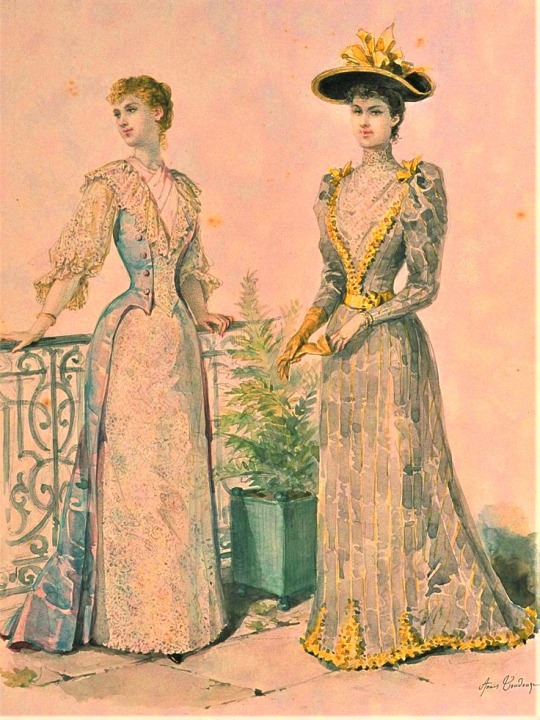


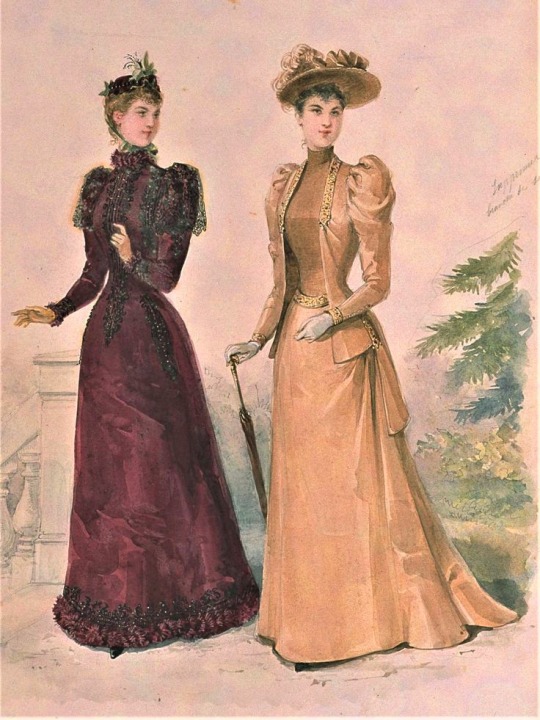

60 notes
·
View notes
Text

La Vraie Mode Oct 29 1905
6 notes
·
View notes
Text
youtube
“Sewing an 1890s Waistcoat! (Victorian Walking Suit Part 1) — Black Snail 0220” By Rushalee Nirodi Sewing
In which I spend a week making a waistcoat because I’m obsessed with the late Victorian silhouette.
2 notes
·
View notes
Text

#historical fashion#fashion#historical#history#historical clothing#historical dress#long dress#victorian#victorian era#textiles#edwardian costume#historically#historical costume#historical pattern#sewing patterns#patterns#artwork#crafts#textile
25 notes
·
View notes
Text
Hey y’all! I have another doll question for you. I want to try to make a doll outfit that’s of like a specific character, but I don’t know what character to make? I found a doublet pattern that looks Jaskier-y but I’ve never actually watched the show so idk
Are there any characters you’d like to see a doll outfit version of, and if so, is there a specific outfit that character wears that is most like them? I think of it as the Scooby Doo Outfit of that character: yes, they sometimes wear something else, but what’s the outfit that comes to mind when you think of them?
...should I make the Scooby Doo outfits????
#what to sew next#well. really what to sew next is the monkey detective#but there's a big fabric fundraiser sale thing this weekend#and I want to hold off sewing the monkey's outfit just in case I find some better fabric there#I really want a tiny houndstooth pattern or like a...idk what it's called#there's a fabric texture I am thinking of but cannot communicate#that screams 'old timey detective outfit' to me#not like wild west detective but like...idk my eras I confuse them even more than fashion decades#uh...victorian? edwardian? original Sherlock Holmes Times detective
3 notes
·
View notes
Text

New pattern up in my shop! Please note: this is a one-size scaled pattern in the style of Janet Arnold.
Following Charles Dickens’s death in June 1870, his effects were auctioned at Christie’s. The public appearance of a portrait of the "Barnaby Rudge" character Dolly Varden caused a craze based on the character and late-eighteenth-century setting that lasted for years. A Dolly Varden ensemble consisted of a long bodice cut with an overskirt, often in a floral print, over a skirt in a contrasting fabric, imitating the “tucked up” gowns of 1780.
This pattern was taken directly from the original, and is presented here in that single size at 1/8 scale. The file consists of a diagram of the dress on a grid in which each box equals one inch; a detailed description of the garment's construction; and photos of the original to assist in understanding and reproduction.
19 notes
·
View notes
Text
I, an amateur teenaged sewist, will once again tackle a victorian tailoring project
#it cant go that badly right? 😃#the late victorian waistcoat i made in the summer turned out fine (despite its flaws) so i don't think this project will flop severely#i've since become more knowledgable about tailoring so this project should go relatively smoothly#btw i'm making an 1890s jacket with ENORMOUS SLEEVES#i need like 4 meters of tweed/thin wool and its gonna be so expensive 😭#i've already spent so much money in recent times that my wallet is having an aneurysm#most of it has gone towards future sewing projects#i bought several patterns from etsy (one of which i bought twice because i'm an idiot)#i spent like 28€ on fabric#i spent another 28€ on a corset busk from amazon#this jacket wool will cost me nearly 80€ and i only have like 150-200€ to my name aksjfbkgjgbbgnfkfhf 😭#girl help#i must do all the sewing#lizard-dumbass talks about stuff#text post
2 notes
·
View notes